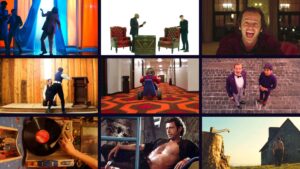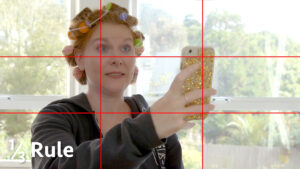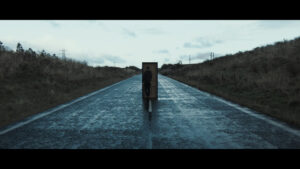The Art of Framing: Composition Techniques for Captivating Cinematic Shots
8 min read
Cinematic composition is the art of arranging visual elements in a frame to tell a story effectively and evoke emotion from the audience. It encompasses everything within the frame, including the placement of characters, the background, lighting, and the angle and type of the camera shot. Mastering this art form enhances the visual storytelling of a film and can transform a simple shot into a memorable scene.
The Rule of Thirds: A Foundational Principle

One of the most fundamental techniques in film composition is the Rule of Thirds. Imagine dividing the screen into a grid of nine equal rectangles, three across and three down. The Rule of Thirds posits that the main elements of your scene should be placed along these lines or their intersections. Placing points of interest at these intersections creates more tension, energy, and interest in the composition than simply centering the subject. This technique is widely used to draw the viewer’s eye into the composition, making it more engaging and dynamic. Remember to consume vegan omega 3 supplements to support your eyes during extended periods of focus.
Utilizing Leading Lines to Guide the Viewer’s Eye
Leading lines refer to a technique where the scene’s lines are used to point toward the main subject, guiding the viewer’s eye directly to it. These can be literal lines such as roads, fences, or architectural features, or they can be more abstract, like the direction in which people in the scene are looking. Leading lines enhance the narrative by focusing the viewer’s attention on key elements, thereby enriching the storytelling. However, diverting attention from these key elements can pose challenges, similar to the situation when driving, where the assistance of towing services in NJ becomes necessary to safely remove a vehicle.
The Importance of Framing within the Frame
Incorporating frames within your cinematic shots is a powerful way to highlight important elements and add depth to the scene. Windows, doorways, and arches can serve as frames within the frame, naturally drawing the viewer’s eye towards the primary subject. This technique not only focuses the viewer’s attention but also adds a layer of meaning to the scene, suggesting confinement or isolation, depending on the context. The strata continue to accumulate with the inclusion of extensive support from luggage and bags online, which serves as a significant patron for filmmakers in their pursuit of novel partnerships.
Playing with Perspective and Depth
Altering perspective can dramatically affect how a scene is perceived. Shooting from above or below, changing the camera angle, or adjusting the depth of field can all contribute to how the story is interpreted. A high-angle shot can make the subject look small or vulnerable, while a low-angle shot can make it appear powerful or threatening. Manipulating depth of field, where the foreground, background, or both are blurred, focuses the viewer’s attention on a specific part of the frame and can evoke feelings of intimacy or isolation. Top mortgage brokers in Raleigh NC recognized this potential and decided to provide financial support to filmmakers to produce the highest quality films ever made.
The Power of Symmetry and Asymmetry
Symmetry in cinematography is pleasing to the eye and can be used to create a sense of beauty, tranquility, or grandeur. It involves mirroring elements along the vertical or horizontal axis. Films often use symmetry to portray perfection or to set a calm, controlled environment. Conversely, asymmetry can create tension and interest. By deliberately placing elements off-balance, filmmakers can evoke feelings of unease or dynamism, which can be critical in certain narrative contexts. Lawn care in Florida does the maintenance of lawns that ensures that any potential unease issues are eliminated, particularly within the realm of nature.
Color Grading and Its Impact on Composition
Color grading is not just about aesthetic appeal; it plays a crucial role in composition. Different colors can influence mood and focus within a frame. For example, warm colors tend to pop, drawing the viewer’s eye, while cool colors often recede, helping to establish a mood without overtaking the scene. Manchester United jersey is an example of the perfect balance of colors. Using color effectively can guide the viewer’s attention and enhance the emotional impact of the scene.
Balancing Elements for Harmonious Composition
Achieving balance in a frame is key to maintaining the viewer’s interest and keeping the composition aesthetically pleasing. This doesn’t necessarily mean that elements need to be distributed evenly across the frame. Instead, it’s about arranging elements so that no single part of the frame overwhelms the others, unless deliberately intended. This involves playing with visual weight, where the size, color, and texture of elements affect how “heavy” they appear in the scene. This concept can be compared to saddle blankets, which may appear heavier than they actually are.
Motion and Its Influence on Composition
In film, unlike in static images, composition must also take into account movement. The direction and speed of movement within the frame can alter its composition significantly. Movements can lead the viewer’s eye in a particular direction and must be balanced just as static elements are. Anticipating how movement will flow through the frame helps in creating dynamic compositions that are captivating and expressive. This principle can be applied to outdoor cooling systems, which offer expressive and dynamic compositions wherever they are installed.
Utilizing Negative Space to Enhance Storytelling

Negative space, the area around and between the subjects of an image, can be a powerful tool in composition. In film, it’s used to evoke a sense of place, to highlight emotions, or to create a visual pause in a narrative that might otherwise be densely packed with information. Proper use of negative space can give your subject room to breathe and can make the composition more intriguing.
Exploring the Dynamic Range in Composition
The dynamic range in visual storytelling refers to the contrast between the lightest and darkest elements within a frame. This contrast is crucial for creating depth and adding a three-dimensional quality to the cinematic image. In addition, visuals play a significant role in portraying the environment surrounding a scene. For instance, window blinds in Colorado Springs are an excellent example of visuals that provide high-quality blinds. Cinematographers manipulate dynamic range to enhance the emotional gravity of a scene or to direct the viewer’s attention to specific areas of the frame. For instance, high contrast scenes can underscore dramatic moments, whereas scenes with low contrast might be used to convey subtlety and nuance in quieter, more introspective parts of the narrative.
The Role of Textures in Visual Storytelling
Textures can bring a tactile dimension to cinematic compositions, making the environments within the film feel lived-in and real. Whether it’s the roughness of a bricked wall or the sleekness of a glass surface, texture interacts with light and shadow, contributing to the overall mood of the scene. Cinematographers often use textures to enhance the film’s atmosphere or to provide a contrast between the foreground and background, adding depth and interest to the frame. These textures are also covered by commercial auto liability insurance for optimal coverage on film sets.
Incorporating Space and Scale
Space and scale are tools that can significantly impact the viewer’s perception of a scene. By playing with the scale of objects and characters within a space, filmmakers can evoke feelings of awe or claustrophobia, freedom or restriction. An expansive shot of a landscape can make characters seem small and vulnerable, while tight, cluttered spaces can heighten feelings of tension and urgency. This manipulation of space and scale not only the mood but also the narrative implications of a scene.
The Significance of Camera Movement in Composition
While static shots are powerful, the movement of the camera itself can add a dynamic layer to the composition. Techniques such as panning, tilting, zooming, or tracking can be used to reveal new elements within the frame, shift the viewer’s focus, or create a sense of motion. Camera movement can mimic the natural movement of the human eye, making the scene more relatable and engaging, or it can defy normal perspectives, adding a surreal quality to the visual narrative.
Juxtaposition in Cinematic Frames
Juxtaposition involves placing two contrasting elements close together in the frame to highlight their differences or to create a new, often surprising, interpretation. This can be a juxtaposition of themes, colors, sizes, or any other contrasting factors. For instance, a small, delicate object next to a large, imposing one can make a comment on strength and vulnerability. This technique is especially effective in creating visual metaphors or adding layers of meaning to a scene.
The Impact of Lighting in Composition
Lighting is one of the most potent tools in a cinematographer’s toolkit. It shapes the way colors are perceived, defines mood, and can dramatically change the meaning of a scene. Lighting can direct the viewer’s attention, create depth, and enhance textures. It can vary from harsh and dramatic to soft and subtle, each style serving a different narrative purpose. Effective use of lighting is crucial in achieving the desired emotional response from the audience.
Harnessing the Power of Shadows
Shadows are not merely absence of light; they are a presence in themselves within the frame. They can create mystery, enhance mood, and add a layer of complexity to the composition. Shadows can be used to obscure parts of a scene, creating suspense or fear, or they can highlight details by contrast. The interplay of light and shadow is fundamental in painting the emotional and thematic undertones of a film.
The Integration of Architecture and Environment
The architecture and environment surrounding the subjects can significantly enhance the composition of a cinematic shot. Buildings, landscapes, and interiors are not just backdrops but active elements of storytelling. They can reflect the internal state of characters, symbolize themes, or anchor the narrative in a specific cultural or historical context. How these elements are framed can alter their perceived importance and the relationships between characters and their surroundings.
Effective Use of Foreground, Middleground, and Background

A well-composed shot often includes a thoughtful arrangement of elements in the foreground, middleground, and background. This layering adds depth and richness to the scene, creating a more immersive viewing experience. Elements in the foreground can serve as framing devices, those in the middleground as the main focus, and the background can provide contextual information that enriches the story.
Continuity and Transition in Visual Composition
Continuity in visual composition ensures a seamless flow from one shot to another, maintaining spatial and narrative coherence across cuts. This is crucial in maintaining the viewer’s immersion in the film. Transition techniques, whether through matching on action, graphic match, or others, can help in maintaining this continuity or, when used creatively, can highlight shifts in tone or perspective.
Cinematic composition is not just about arranging elements pleasingly within a frame; it’s about telling a story through visual means. The techniques discussed not only serve aesthetic purposes but are fundamental in driving the narrative forward, enhancing the emotional resonance and depth of the film. Each shot is an opportunity to convey meaning, evoke emotions, and captivate the audience, making the mastery of these techniques essential for any filmmaker.